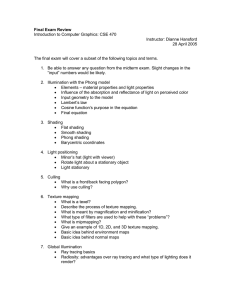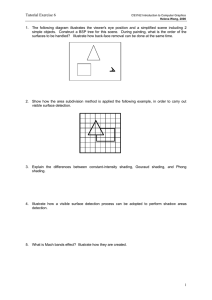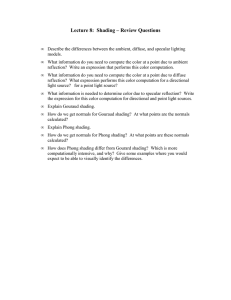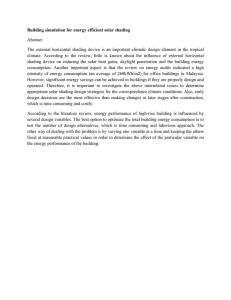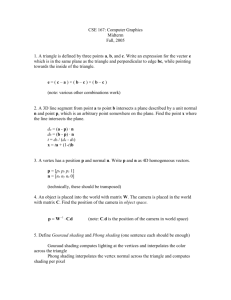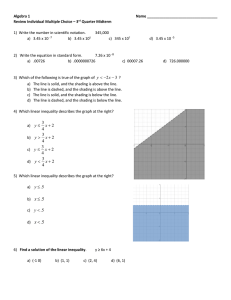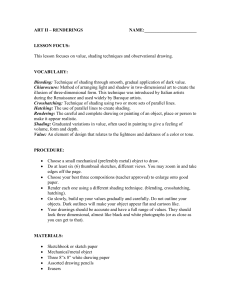Illumination Models for Graphics
advertisement
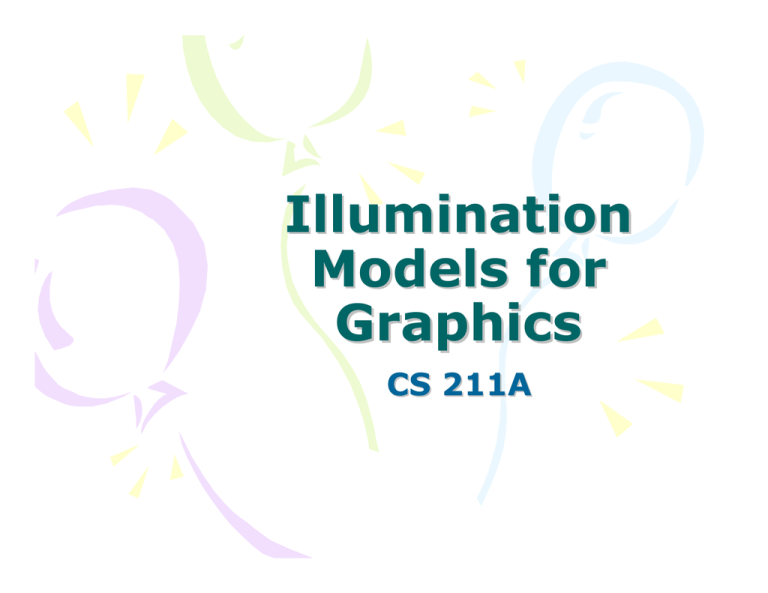
Illumination Models for Graphics CS 211A Can be very complex • The incoming light can come from a source, or bouncing off another object, or after multiple bounces • Sources can be extended • Multiple interactions between light and surface Very simple models • Assumes point light source • Models only the direct illumination from the source – Does not consider light reaching after bouncing off other objects • Illumination models evaluated only at the vertices For every vertex • Ambient component • Diffused component • Specular component Ambient Component • Equal amount of light from all directions • Approximates the indirect illumination • Iaka – Ia = intensity of ambient light – ka= percentage of the light reflected by the object Lighting at a point on surface • I = Idkdcosθ – Id = intensity of light – kd = coefficient of diffuse reflection • I = Idkd(N.L) N L R θ θ P Surface Diffused Component • I = Idkd(N.L) • Id(N.L) is like the irradiance • kd is like the reflectivity • No dependency on viewer – View independent N L R θ θ P Surface Ambient and Diffused Lighting I = Ipkd(N.L) I = (Iaka +Ipkd(N.L)) Specular Component • IsksCosn(α) • Cos(α): fall off as V moves away from R • n gives the sharpness R L θ θ P α V Specular Component • R depends on L • Depends on both V and L • Like the BRDF • n controls the view-dependency also R L θ θ P α V Providing Control • Providing enough control so that one can simulate effect via trial and error of many different parameters • May be not be close to the physical phenomenon • For e.g. Different brightness of the same light can be used for different component computation Attenuation Control • Diffused component • I = Idfattkd(N.L) – fatt = 1/(a+bd+cd2) • d = distance of light from the surface • a, b and c are user defined constants Attenuation of Light a=0, b=0, c=1 a=0.25, b=0.25, c=0.5 a=0, b=1, c=0 Increasing distance from the light source Other issues • (Iaka + Idkd(N.L) + IsksCosn(α))O • For different channels – Do the same operation for all channels • Multiple lights – Only one ambient light source – Multiple point light sources • Addition of light from different light sources Ambient Ambient + Diffuse Ambient + Diffuse + Specular What is Shading? • Illumination model • How do we use these models to shade the triangles in the graphics pipeline? • How did we generate the picture on the right? Method • Evaluate illumination model at the vertices of the triangles – After model-view transformation • Use interpolation to color the interior of the triangles during rasterization – Different shading methods use different interpolation • Assume that the polygonal models approximate smooth surfaces Normal Computation A N • Normal of a triangle – N = (B-A) x (C-A) • Vertices are in anticlockwise direction with respect to normal • Normal of a vertex – Average of all the triangle incident on the vertex – Nv = (N1+N2+N3+N4)/4 C B Constant/Flat/Faceted Shading • Illumination model applied once per triangle • Using normal of the triangle • Shade the whole triangle uniformly – Color associated with triangles and not vertices Gouraud Shading • Interpolating illumination between vertices – Calculate the illumination using vertex normals at vertices – Bilinear interpolation across the triangle Gouraud Shading • Edges get same color, irrespective of which triangle they are rendered from – Shading is continuous at edges • Tends to spread sharp illumination spots over the triangle Phong Shading • Interpolate the normal across the triangle • Calculate the illumination at every pixel during rasterization – Using the interpolated normal • Slower than Gouraud • Does not miss specular highlights – Good for shiny specular objects Gouraud vs. Phong Shading Gouraud Phong Gouraud Phong Spreads highlights across the triangle Misses a highlight completely Flat Shading Gouraud Shading Phong Shading Shading • Independent of the Illumination model used • Phong Shading and Phong Illumination • Artifacts – Piecewise planar approximation – Screen Space Interpolation • Simple and hence widely used Artifacts: Mach Bands At discontinuities Actual Intensity Percieved Intensity Artifacts: Mach Bands • Common in flat shading since shading is discontinuous at edges • Also present in Gouraud shading – Gradient of the shading may change suddenly • Phong shading reduces it significantly – But cannot be eliminated – At sharp changes in surface gradient Artifacts: Screen Space Interpolation S1 • Shading is interpolated while rasterization • Sp = (S1+S2)/2 – zs = (z1+z2)/2 Sp S2 Artifacts: T-junctions • The shading at the T-junction are different when calculated from different triangles • Shading discontinuity B A D C Artifacts:Vertex Normals • Vertex normal does not reflect the curvature of the surface adequately –Appear less flat than it actually is
